What is Project Execution? Best Practices and Real Tool Support

A strong plan doesn’t guarantee successful delivery. What matters is execution, the ability to stay clear-headed under pressure, adapt quickly, and keep moving forward. In fact, 66% of project managers define execution success by the “triple constraint”: cost, scope, and schedule, according to Embry-Riddle Aeronautical University.
While these may start off balanced, they often shift dramatically during execution. Without active oversight, each milestone becomes a risk point. Even the best strategy falters without disciplined execution. That’s where project managers need support, not more plans, but smarter tools.
Modern project execution software, such as Meegle, provides the necessary support to help track drift, realign goals, and restore velocity when projects wobble midstream.
What is project execution?
 Project execution (evolving actions influencing progress) (Source: Freepik)
Project execution (evolving actions influencing progress) (Source: Freepik)Project execution is a phase where strategic intent is translated into visible outcomes, making it one of the most high-stakes phases in the project lifecycle. Execution is the phase that tests if what’s being delivered has real business value.
Operational components of project execution processes
These are the moving parts that directly control the delivery of project’s scope is delivered, along with time use and cost accumulation.
1. Managing processes (execution path)
 Process management (Source: Freepik)
Process management (Source: Freepik)Execution requires translating governance into adaptable workflows such as SOP, or playbooks. If workflows aren’t designed to flex under the triple constraints, even high-performing teams end up improvising, which can cause inconsistent in quality of output or a devistion in timeline.
2. Managing people (execution resilience)
 People management (Source: Freepik)
People management (Source: Freepik)Execution lives or dies by team dynamics, accountability, and trust. The rise of cross-functional, remote, and hybrid teams makes people management non-trivial. Understanding each team member’s strengths, limitations, and available bandwidth is essential to execution.
3. Managing communication (execution control)
 Communication management (Source: Freepik)
Communication management (Source: Freepik)Sending regular updates is a staple in many organizations. But the challenge is not frequency, it’s how various team members interpret and act on information when stakes are high.
To manage execution at scale, you need to understand the broader goals, team rhythms, and control systems that define a successful project execution phase. To do this, you need to focus on these key questions:
What are the core objectives and outcomes of project execution?
The primary objective is to convert intent into tangible value through deliverables that are functional, approved, and aligned with stakeholder expectations.
Execution success is measured by how well business outcomes align with what was scoped and funded, and whether the deliverables were completed on time.
Suggested resource: Project Deliverable Tracking Template
What are the key activities that drive product execution?
The most successful teams maintain progress by building routines around accountability. Activities, such as status check-ins, reassignments when delays occur, and adjusting workload distribution, should be implemented to maintain momentum.
What techniques support structured execution?
Gantt Charts, Kanban boards, and Critical Path analysis help teams visualize sequences and constraints more effectively. Real-time dashboards, issue logs, and time tracking tools help surface drift early.
These techniques create structure, reduce ambiguity, and allow you to manage complexity without micromanaging people.
Read more: 👉How to Adapt Critical Path Method in Meegle
Why must project execution integrate with monitoring and controlling?
Execution and control are concurrent and must go hand-in-hand. Teams must monitor performance against baselines and act quickly at the first sign of deviation.
This phase-level integration ensures that execution follows an adaptive structure for every activity, both upstream and downstream.
What are the deliverables and documentation produced in this phase?
Execution leaves behind proof of how outcomes were achieved. These include completed deliverables that have been reviewed against acceptance criteria, as well as formal documentation. These records track traceability and readiness for final stakeholder approval and closure.
Common Project Execution Strategies
Execution strategies define how a project plan is transformed into coordinated action. These frameworks guide task flow, decision-making, and resource allocation, ensuring execution aligns with project goals under real-world constraints.
Selecting the right approach depends on several factors, including project volatility, stakeholder expectations, team structure, and delivery cadence. Below is a breakdown of widely adopted execution strategies and when each is most effective:
| Strategy | Ideal Use Case | Execution Characteristics |
|---|---|---|
| Waterfall | Projects with fixed scope and minimal iteration (e.g., infrastructure upgrades, regulatory initiatives) | Sequential phases, locked requirements, formal reviews at each stage |
| Agile | Workstreams requiring flexibility and fast delivery (e.g., digital product development, iterative marketing) | Incremental releases, backlog prioritization, feedback loops after every sprint |
| Scrum | Teams operating in sprint cycles with defined roles | Time-boxed iterations, daily standups, fixed deliverables per sprint |
| Kanban | Projects focused on continuous flow and task visibility | Visual task boards, pull-based work allocation, strict WIP (Work in Progress) limits |
| Critical Chain Project Management (CCPM) | Initiatives where resource constraints impact schedule (e.g., hardware development, R&D) | Buffer-driven timelines, resource-centric planning, active risk management |
| Hybrid | Cross-functional programs that balance adaptability with structure | Combination of Waterfall for governance and Agile for iterative workstreams |
Each strategy establishes a different mode of control and accountability during execution. Waterfall emphasizes predictability through structure, while Agile supports continuous adjustment based on feedback. Hybrid approaches offer cross-team alignment by blending planning discipline with delivery flexibility.
Why project execution is important?
Some of the benefits of project execution include:
- It serves as the proving ground for cross-functional alignment: Execution forces interdependencies to surface. Execution exposes interdependencies. It quickly reveals whether alignment was real or assumed, often only visible when deliverables clash.
- It reveals the true operational capacity of your organization: Execution reflects performance under the real constraints you face. At this stage, you’ll be able to see how much throughput your structure can sustain under actual operating constraints.
- It acts as a real-time pulse check for organizational agility: Your response to unexpected changes during execution shows how adaptive your teams are. Execution performance is often a direct proxy for enterprise-level flexibility and decision velocity.
- It turns project management frameworks into behaviors: Execution translates frameworks like Agile or lean into visible behavior. You’ll see the difference in how consistently teams move through cycles and avoid ad-hoc decision-making.
- It builds the institutional memory for better forecasting: Execution data (what slowed you down, what helped unblock) informs realistic timelines and resource planning in future projects, something you can’t learn from plans alone.
Difference between project execution and project planning
Planning sets the vision, while execution exposes how well that vision holds under real-world pressure. Without treating them as distinct phases, teams risk misjudging readiness and overlooking execution risk.
| Aspect | Project planning | Project execution |
|---|---|---|
| Primary function | Establishes intent, structure, and scope | Converts intent into action and measurable outcomes |
| Nature of activity | Predictive, based on assumptions and ideal conditions | Responsive and evidence-driven |
| Information flow | Top-down communication: objectives → tasks | Bi-directional: tasks inform adjustments to objectives |
| Handling change | Anticipates change through scenarios | Absorbs real change through decisions and realignment |
| Tooling focus | Roadmaps, Gantt Charts, resource forecasts | Workflows, status dashboards, issue tracking, progress alerts |
| Leadership mode | Centralized coordination and task definition | Decentralized decision-making and execution governance |
| Output form | Plans, timelines, budgets, risk registers | Deliverables, logs, performance outcomes |
| Time orientation | Future-focused (what should happen) | Present-focused (what is happening) |
| Team behavior | Alignment around expectations and assigned scope | Coordination under shifting conditions and pressure |
| Feedback cycle | Infrequent and milestone-based | Continuous and task-by-task |
The planning and execution phase in project management and serve different functions. In practice, optimizing the triple constraint—CSS&Q (Cost, Scope, Schedule, and Quality)—requires planning and execution to work in sync.
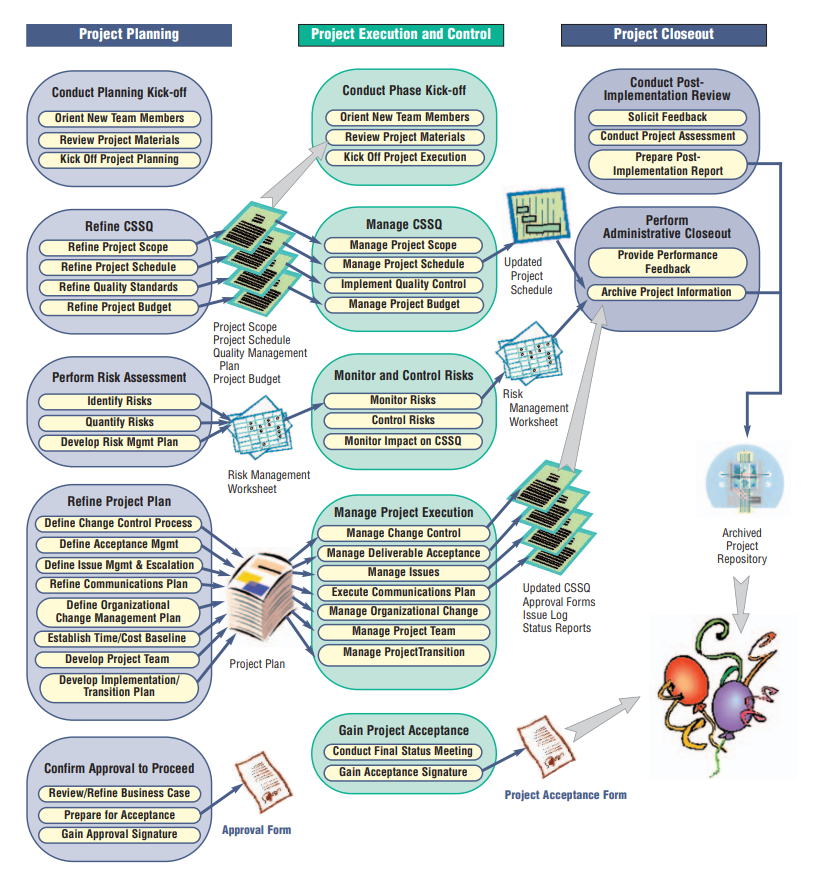 Relationship between project planning and execution in CSS&Q (Source: Kautilaya Society)
Relationship between project planning and execution in CSS&Q (Source: Kautilaya Society)We can see in the chart that planning activities like “Refine Project Scope,” “Refine Budget,” and “Refine Quality Standards” all sit under the planning phase, forming part of the initial project definition.
In the execution phase, activities like “Manage Project Scope,” “Implement Quality Control,” and “Manage Project Budget” mirror planning actions as ongoing, dynamic loops.
This relationship demonstrates that CSS&Q is never set in stone and is a continuous negotiation that spans both phases. Tracking CSS&Q in execution requires constant reconciliation with on-ground delivery dynamics.
This continuity also shapes how project closeout is conducted. Closeout activities, such as “Provide Performance Feedback,” “Archive Project Information,” and “Prepare Post-Implementation Report”, depend entirely on how well CSS&Q was maintained throughout the project lifecycle.
Common challenges in the project execution phase
According to 15th edition PMI’s Pulse of the Profession, only 73.8% of projects globally meet their original goals, reminding us that many still fall short. While still in the B+ zone, it still reminds us that many other projects limp along and rarely hit top form.
Some issues that may arise in this phase of project life-cycle management include:
Execution gaps
 Plugging the execution gaps (Source: Freepik)
Plugging the execution gaps (Source: Freepik)The execution decisions happen in the exec offices. Projects often involve C-suite leaders, middle managers, PMs, and delivery teams. Without strong coordination between these layers, misunderstandings and misalignments are inevitable.
For instance, a VP might assume a market requirement is being prioritized, but down the chain a team may have interpreted it as a long-stretch goal. And no, there’s no universal fix for this.
You can’t close as easily as you might in a product rollout or a regulatory migration. The spectrum of variability is too wide, from org structure and incentives to how fast decisions can propagate.
A more productive approach is to ask:
Don’t ask, “How do we close the gap?” but, “Where exactly is the handoff breaking down in this system?”
Sometimes, the most valuable move is to map your internal execution system just like you would do in a supply chain business. The clarity this brings can help your PM team spot where the context or ownership is lost.
Sponsors disappear post-kickoff
 Caution on sponsorship inclusion (Source: people matters)
Caution on sponsorship inclusion (Source: people matters)Sometimes the problem is not always disengagement but overcommitment. Kickoff enthusiasm often creates a burst of attention that quickly fades.
Sponsors, often senior leaders juggling competing priorities, are difficult to fully engage without structure. Without a structured check-in cadence, the project risks fading into the background.
To avoid this:
- Build sponsor responsibilities into the execution calendar and treat their input like a resource. Schedule it!
- Use milestone review meetings as decision checkpoints. These are ideal moments to surface trade-offs while sharing progress.
- If you sense drift, reframe sponsor communication around the outcomes at risk. Avoid updates focused on task-level details, they can overwhelm and fatigue senior stakeholders.
Poor leadership
 The blue pawn is still a pawn - make sure managers actively evolve in collaboration and separation on what good leadership is (Source: Freepik)
The blue pawn is still a pawn - make sure managers actively evolve in collaboration and separation on what good leadership is (Source: Freepik)Poor execution leadership often looks like this: You have a team that keeps working but isn’t sure if priorities have changed. Standups take place, but they rarely translate into decisive action.
To address this leadership gap, consider the following interventions:
- Coach middle managers on leading through constraints and not just sending in reports.
- Establish decision velocity metrics, like time-to-resolution for critical blockers, to track responsiveness.
- Define escalation paths in advance: If a dependency slips, clarify who takes over and who was accountable before the issue occurred.
Strategic drift
 Strategic drifts cause unclear definitions of purpose-driven paths (Source: Freepik)
Strategic drifts cause unclear definitions of purpose-driven paths (Source: Freepik)You’ll find common situations where the project might be on time and on budget, but no longer on purpose. This often happens when teams are line-focused, heads-down executing, but no one is working actively to pull the strategic thread through day-to-day choices.
You don’t fix this by adding more meetings or reciting the mission statement. Instead:
- Re-anchor execution priorities to business impact weekly.
- Treat trade-offs as strategy decisions, not operational ones. If, for example, a scope cut saves time but kills a revenue lever, someone has to say it out loud.
- Involve sponsors in milestone reviews to enable earlier course correction.
Performative change control
 Change-induced fatigue from re-plotting courses without proper baseline recalibration (Source: Freepik)
Change-induced fatigue from re-plotting courses without proper baseline recalibration (Source: Freepik)Real execution pressure reveals inaccurate estimates, unmet needs, or capability gaps. These should trigger proactive change management and not a reactive justification. Knee-jerk changes often cause confusion and lead to decision fatigue.
If the project manager fails to recalibrate the project baseline after approved changes (modifying durations or resource allocation), the new reality almost does not get reflected in tracking. What you’re monitoring, then, isn’t the project as it is, but the plan as it used to be.
In the CSS&Q framework, change management is grouped under project execution. This is because it’s during this phase that estimates take a hit and need readjustments (tweaks that are necessary and sometimes risky).
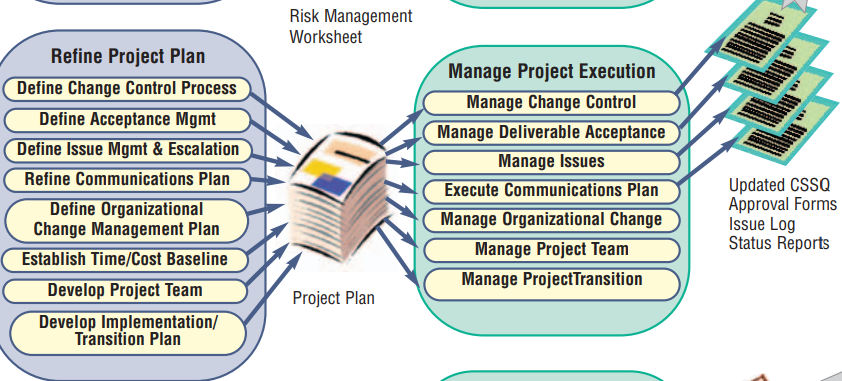 Relationship between defining change control processes in plans and managing it in execution (Source Kautilya Society)
Relationship between defining change control processes in plans and managing it in execution (Source Kautilya Society)To avoid performative change control:
- Tie every change request to a clearly analyzed impact.
- Update dependencies, durations, and resource allocations immediately, no delays.
- Re-baseline schedules and budgets post-approval (if you skip this, you’re still executing against a ghost plan).
- Track the total cost of approved changes separately to measure actual drift.
Ineffective corporate governance
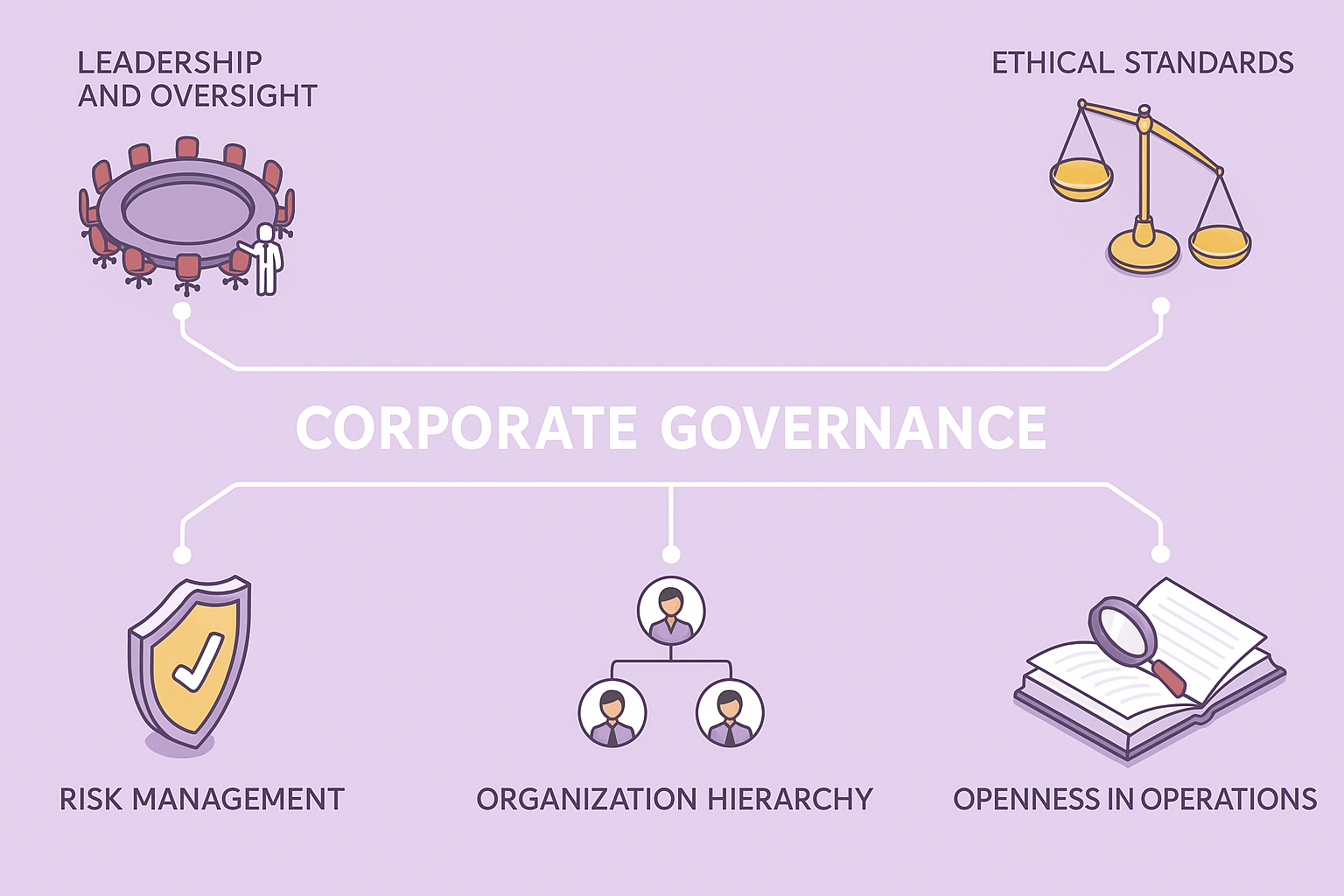 Corporate governance - The architecture behind accountability (Source: GenAI - Inspo - Freepik)
Corporate governance - The architecture behind accountability (Source: GenAI - Inspo - Freepik)Poor governance slows execution and blurs accountability. Without clear engagement during scope changes and risk responses, teams and processes operate without direction.
High-functioning governance during execution should look like this:
- Define decision thresholds: Who decides what, at which level, and what decisions can proceed without escalation.
- Time-bound decision windows: If a steering committee can’t respond within 48 hours, fallback protocols should trigger.
- Execution-aware governance bodies: Include representation from coal-faced teams on the project, and not only top-floor strategists.
Inadequate project management tools
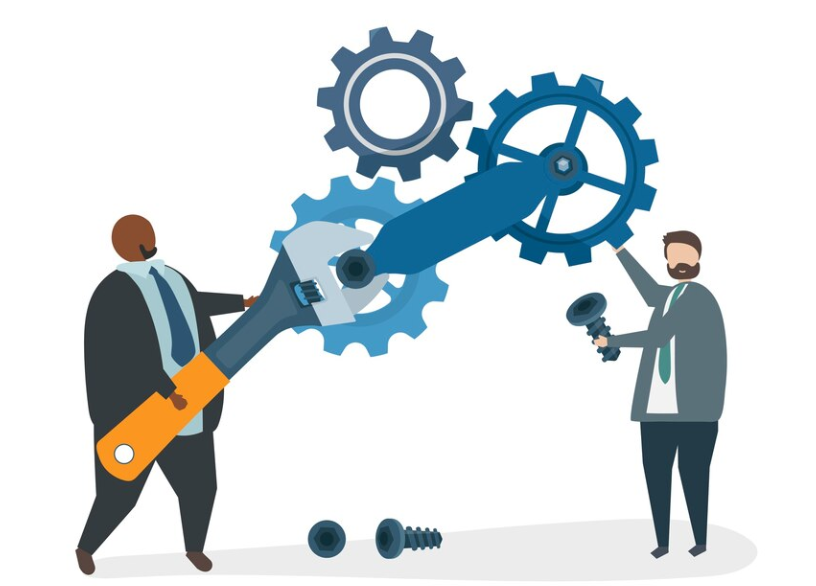 Too many parts in legacy software need constant oiling and tightening, leading to tackling tool inefficiencies rather than the projects (Source: Freepik)
Too many parts in legacy software need constant oiling and tightening, leading to tackling tool inefficiencies rather than the projects (Source: Freepik)Bloated legacy tools still linger, often causing more friction than value in today’s fast-paced work environment. These systems fail to surface issues quickly and demand excessive manual updates. Over time, this slows execution or even causes it to regress.
Good tools do more than track tasks. They can integrate decisions, context, and momentum. Meegle, for instance, visualizes work and ties job progress to change impact, shows live milestone status, and triggers auto-updates when upstream changes affect dependent timelines.
Execution speed is no longer just about effort, but also about how quickly your stack can make the project's current state visible and actionable at a glance.
Features to look out for in a project execution tool
Project environments are volatile, so it's essential to use tools that can handle change effectively. Some features to look out for include:
1. Live milestone performance tracking
When execution is in motion, stakeholders need real-time insight into what job is due and how each milestone is doing under pressure.
Meegle supports this with:
- Execution-aware OKR tracking dashboard: Surface goal status using the OKR management software. You can also use the data to identify velocity anomalies about associated tasks, milestones, and deadlines. Teams can define shared objectives, track project progress, assign measurable key results, and monitor them in real time.
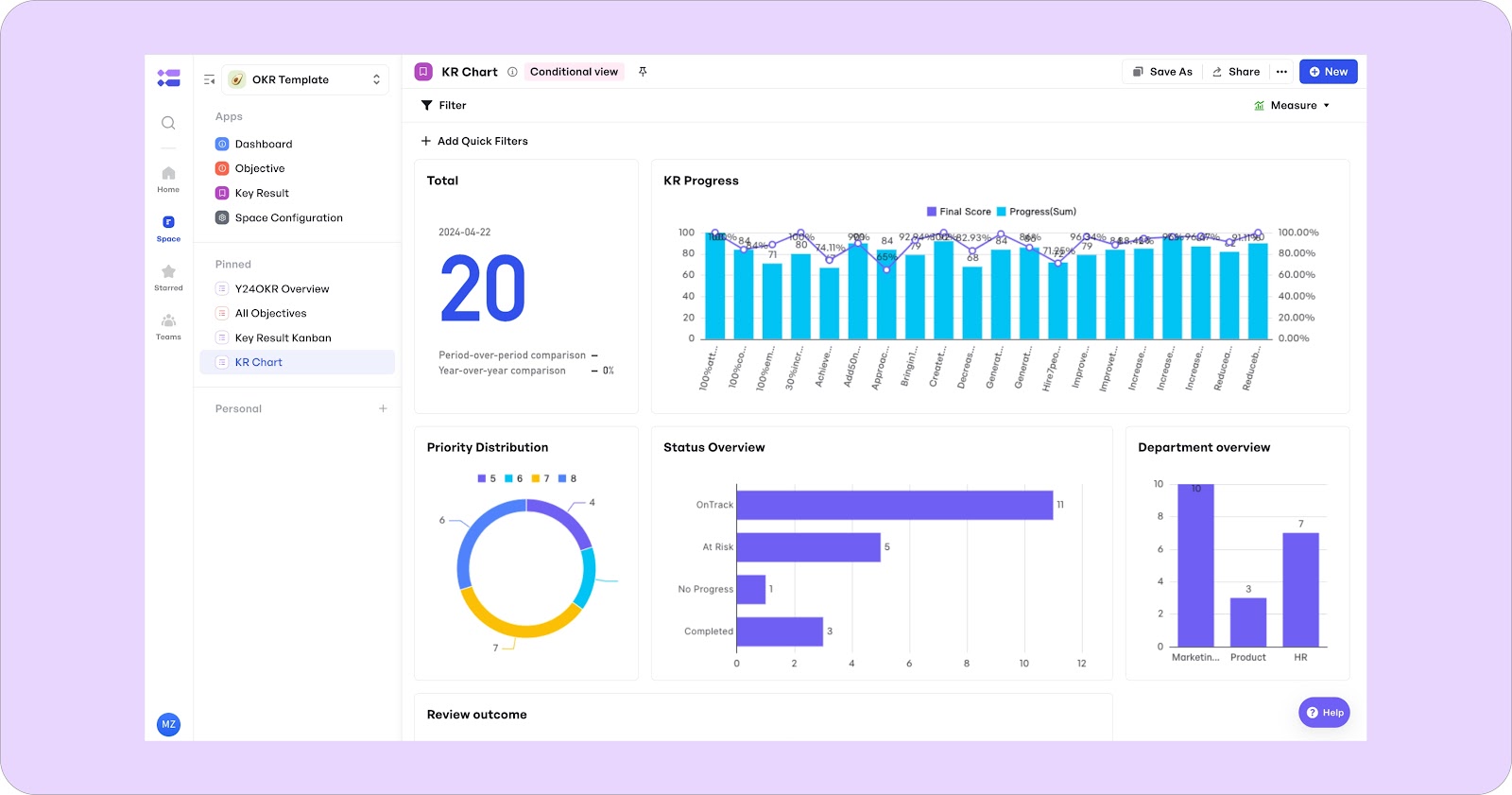 Monitor performance trends with KR reporting charts
Monitor performance trends with KR reporting chartsSuggested read: 👉Master OKR Implementation
- Baseline linkage and delay tracking: Create a project baseline linking tasks and milestones, and then monitor actual vs. planned dates. Meegle also automatically flags delays in Gantt Chart.
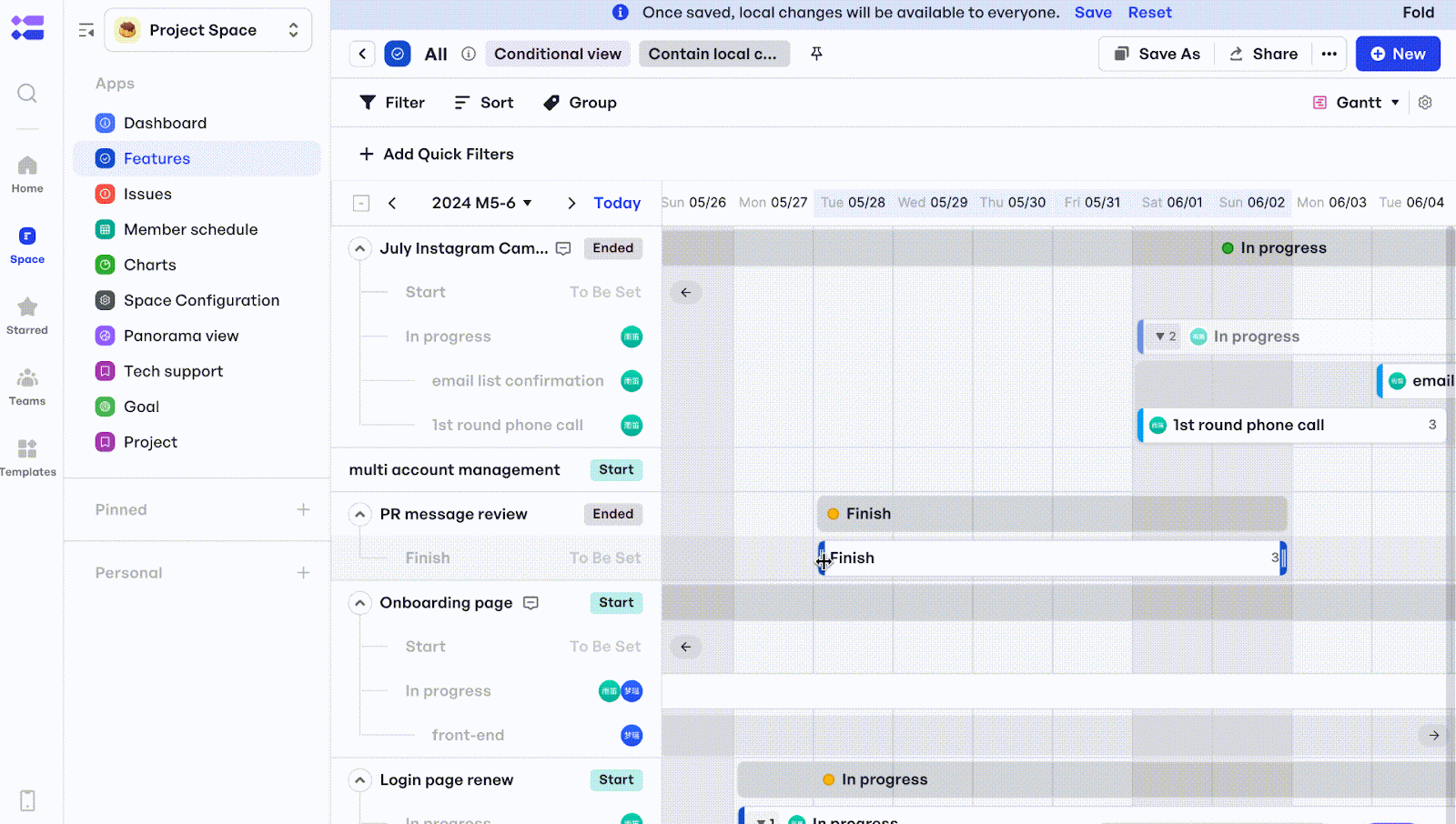 Gantt Chart illustrating baseline timelines and real-time progress to support clear and effective project reporting.
Gantt Chart illustrating baseline timelines and real-time progress to support clear and effective project reporting.- Iteration-specific lifecycle templates: Built-in project ifecycle templates let teams define iteration milestones and measure stage-by-stage velocity with clarity.
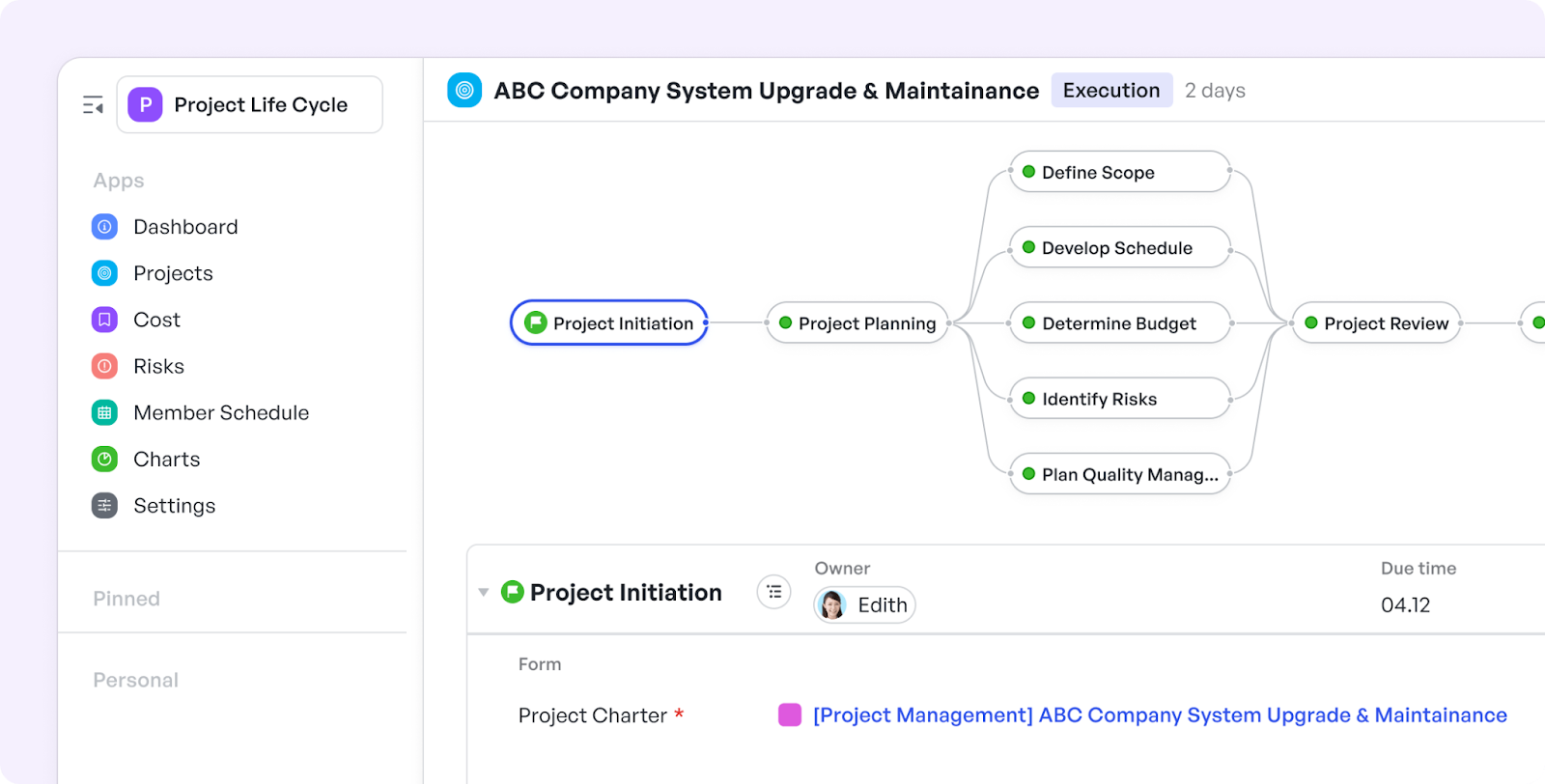 Meegle project lifecycle template
Meegle project lifecycle template2. Execution-phase change visibility
We’ve established that drifts always happen in execution so having a tool that helps you with complete visibility as regards change management is extremely handy.
Meegle delivers project execution change management using:
- Built-in change logs: Automatically records updates whether they’re structural edits, visibility toggles, or team and role adjustments across workflow views and tabs. You gain a transparent audit trail of what changed, when, and by whom.
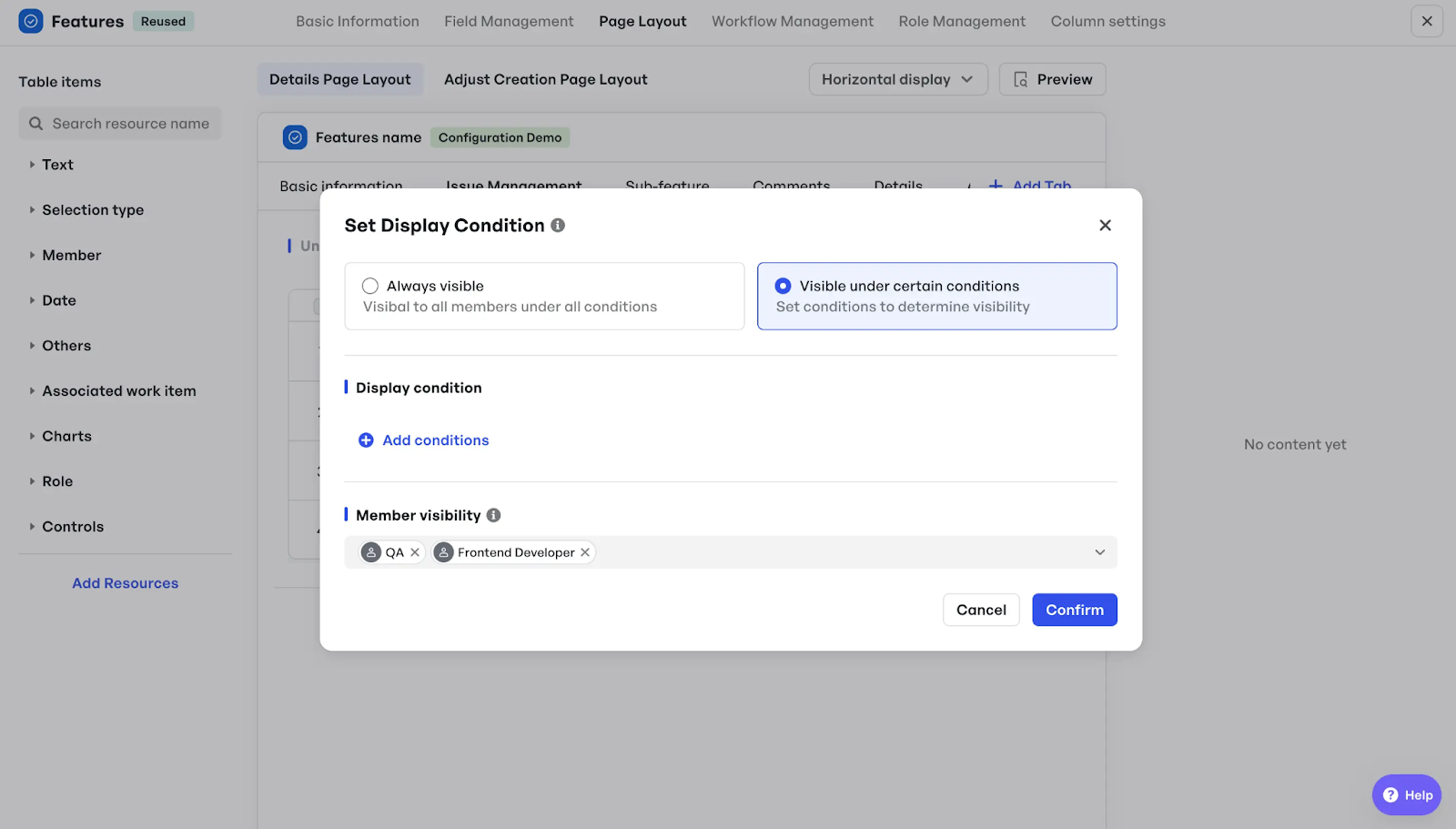 Administrators can set visibility range for tabs according to members, roles, and teams.
Administrators can set visibility range for tabs according to members, roles, and teams.- Impact-forward change workflows: Set changes to trigger automation, like affected tasks that alert their owners with stakeholders looped in. Registered changes filter directly into timeline and resource views with no manual catch-up needed.
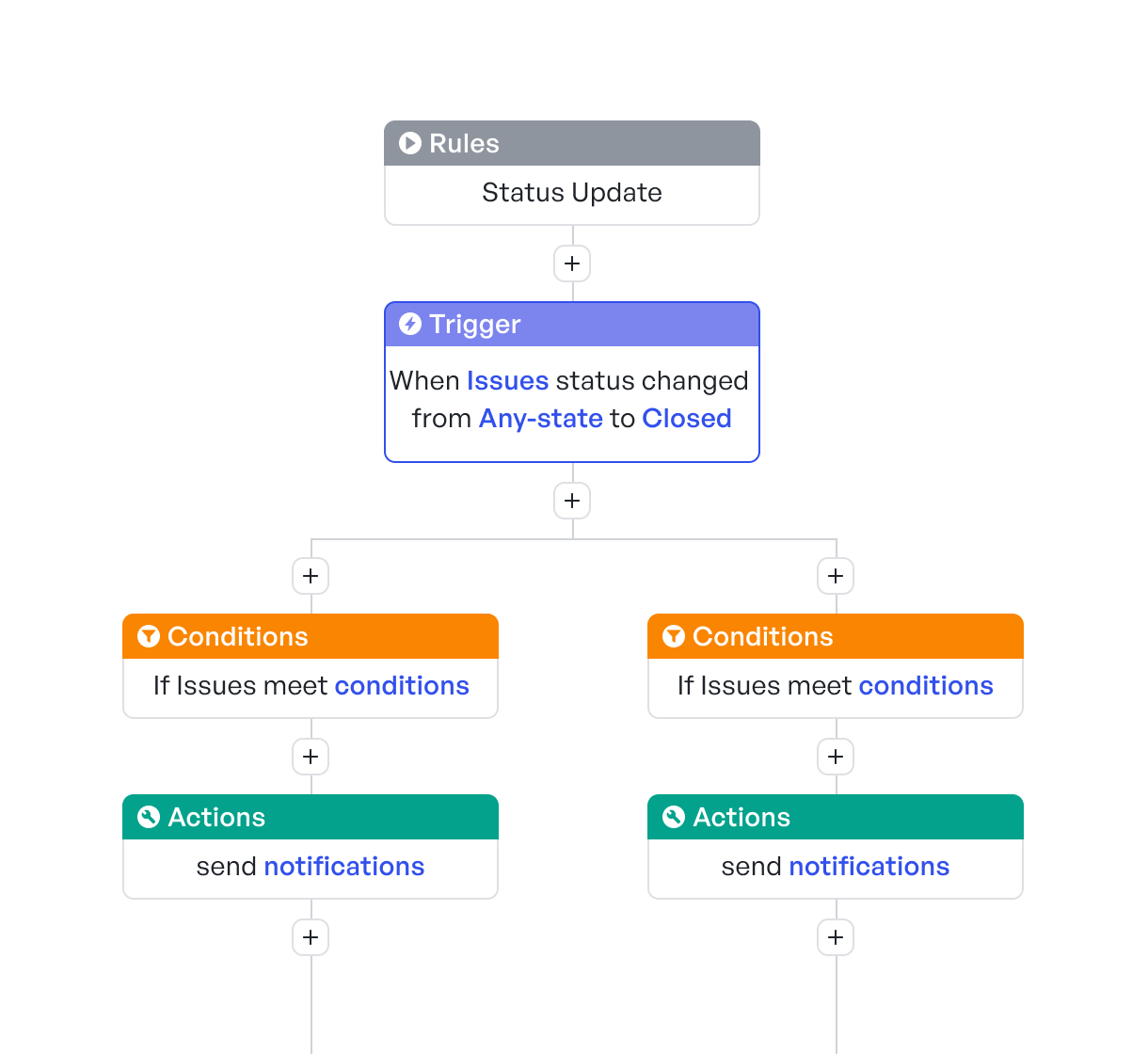 Set automated workflows for status changes made within the project’s execution
Set automated workflows for status changes made within the project’s executionAnd if you have issues setting up a fluid automation tree, you can utilize our custom workflow trigger configuration template.
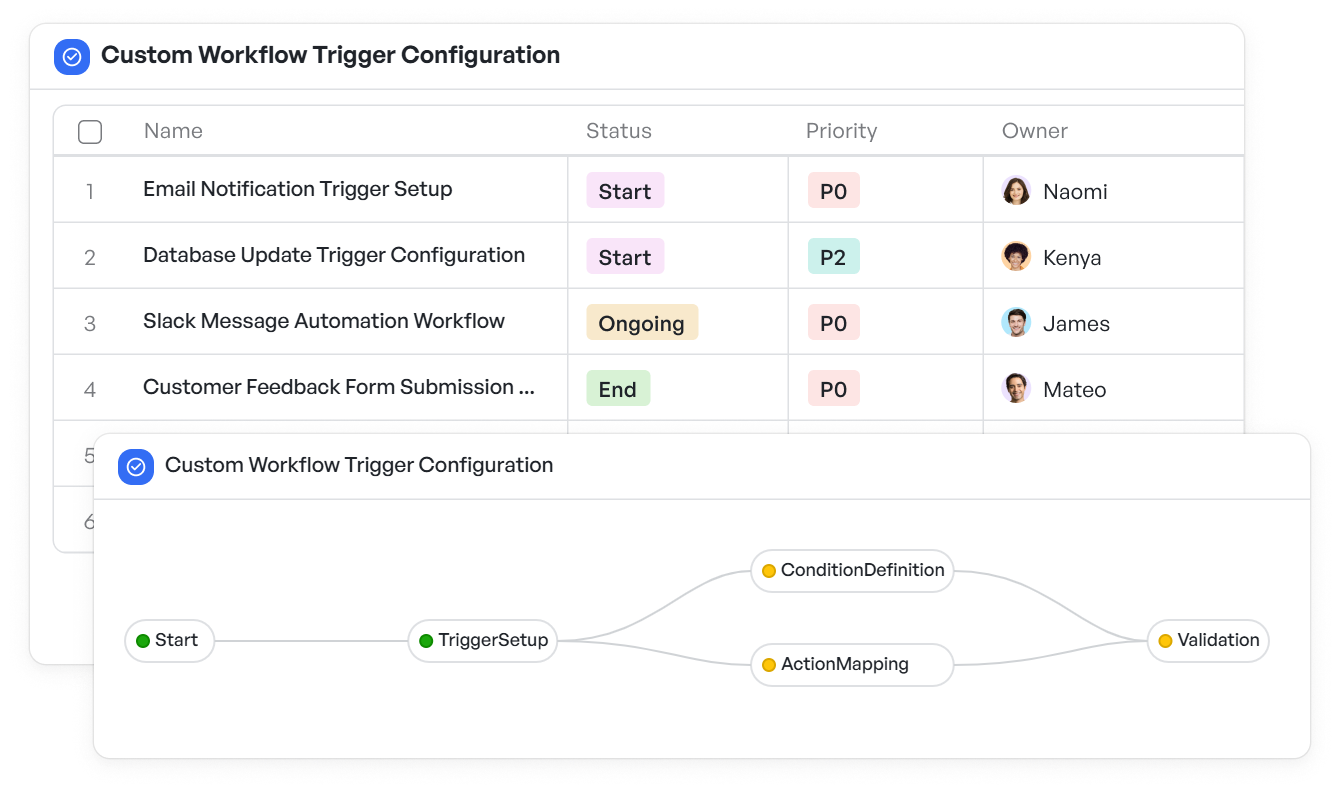 Meegle custom workflow trigger configuration template
Meegle custom workflow trigger configuration template3. Conditional and adaptive routing
Find a tool that prioritizes conditional logic. This ensures only relevant steps are triggered based on real-time inputs, minimizing clutter and sharpening execution decisions.
Meegle delivers this via its:
- Conditional logic templates: Meegle’s SOW Template with conditional logic allows workflows to adjust dynamically based on project inputs, for example, switching between frontend, backend, or full-stack flows depending on initial scope.
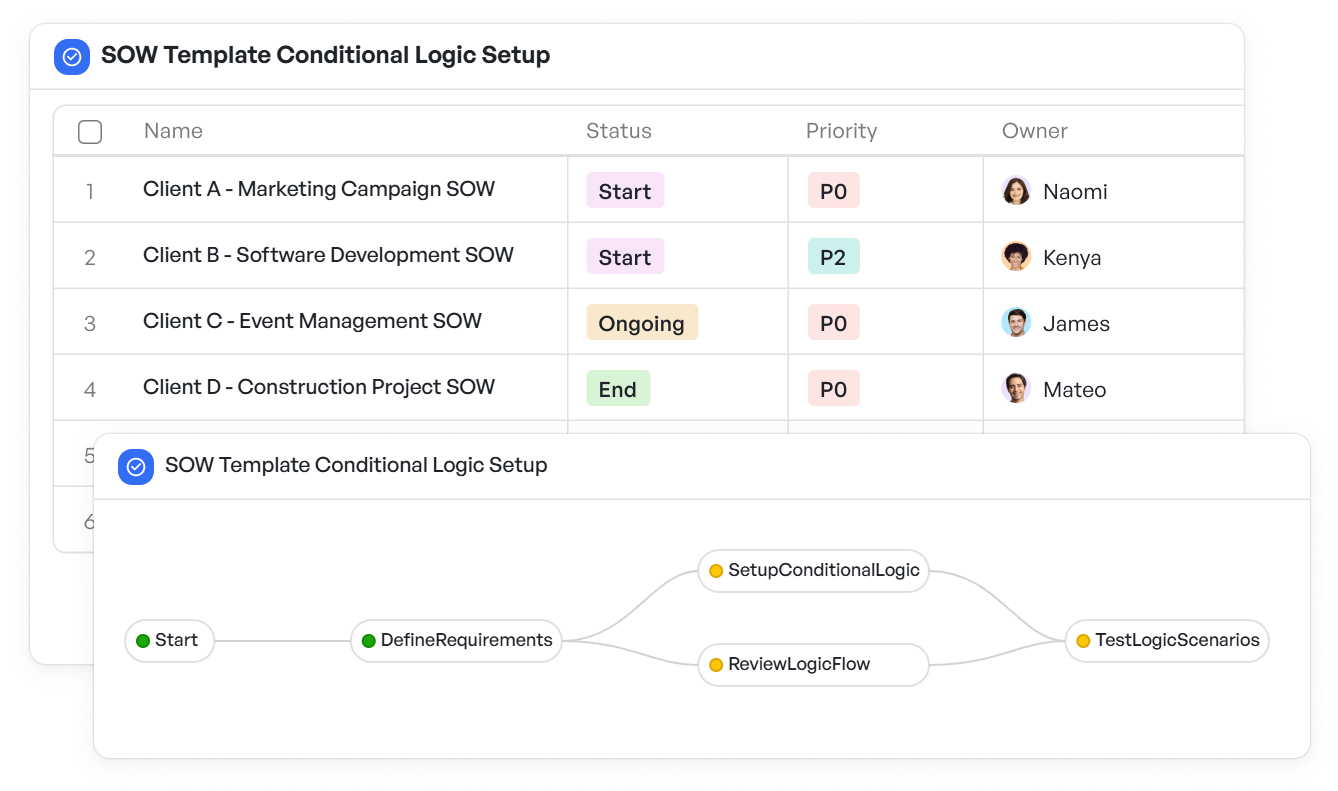 Meegle SOW template conditional logic setup
Meegle SOW template conditional logic setup- Visual workflow builder: With Meegle's node-driven workflow canvas, you can build branches and routing rules visually. For example, a “Yes/No” node can trigger different approval sequences based on responses, making execution paths adaptive without manual intervention.
 Setting a node’s condition in Meegle
Setting a node’s condition in Meegle4. Cross‑stream dependency mapping with live sync
In cross-functional teams, real-time updates are essential to maintain alignment and prevent miscommunication.
Meegle encourages this by using automatic synchronization across views. Task adjustments in one stream ripple across Gantt and Kanban views, updating schedules and notifying stakeholders in real time. This maintains data consistency without redundant data entry.
5. Automated accountability nudges
When tasks go overdue or unnoticed, execution momentum drops, impacting delivery performance. Automated nudges prevent this by making neglect visible before it rolls into bad delays.
Meegle supports consistent execution with smart alerts for upcoming and overdue tasks, and adapts to shifts in dwell time or task status.
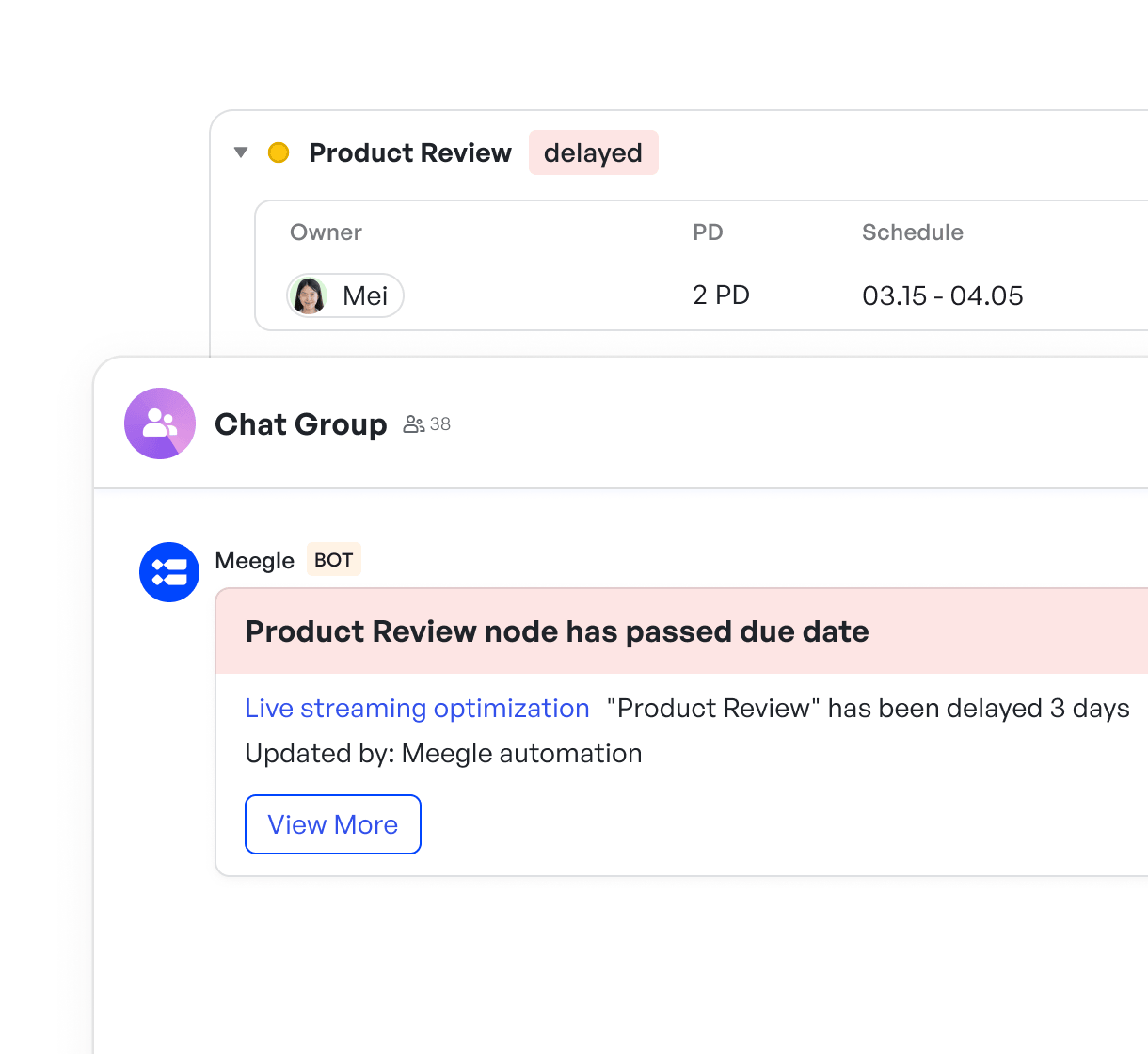 Meegle smart deadline reminder
Meegle smart deadline reminderBest practices for successful project execution
No single action guarantees flawless execution, but the right habits always compound. These best practices are chosen for the outsized return they deliver over time:
1. Make sure everyone is on the same page
Don’t mistake kickoff energy for real alignment. Alignment is proven after execution begins. Try to consistently reinforce it by making shared timelines, responsibilities, and outcome expectations visible and revisitable in real time.
2. Manage teams by roles
Structure your team execution around defined roles with explicit authority and accountability per task node. It helps to clarify decision-making during high-pressure moments.
3. Make handoffs frictionless
Design handoff moments with clear transition protocols, task status, documentation, and dependencies, so teams can continue without delays or context gaps.
4. Build a culture of timely escalation
Normalize early escalation. Let your tooling reflect this by enabling direct route-ups and live blockers, so silence never equals progress.
5. Support mixed methodologies without judgment
Execution styles differ, and what works for engineering may stall in marketing. Tools and workflows should allow Agile, Waterfall, and hybrid teams to coexist, connect, and adapt across execution streams without forcing too much standardization.
6. Replan without starting over
The need to change course doesn’t mean trashing the project plan. Build adaptive planning as you go with buffers and decision gates where project paths can branch based on live feedback. Your tool should allow rescoping without displacing your execution memory.
7. Turn feedback into an execution advantage
Execution should be treated as a feedback system. Create tight feedback loops around blockers, errors, and missed goals, then make feedback visible and loop it into task structures.
8. Let deliverables speak for themselves
You don’t need excessive justification when your outputs are traceable and verifiable. Define acceptance criteria clearly, automate validation wherever possible, and make review processes data-backed and audit-friendly.
How Meegle helps with the project execution process
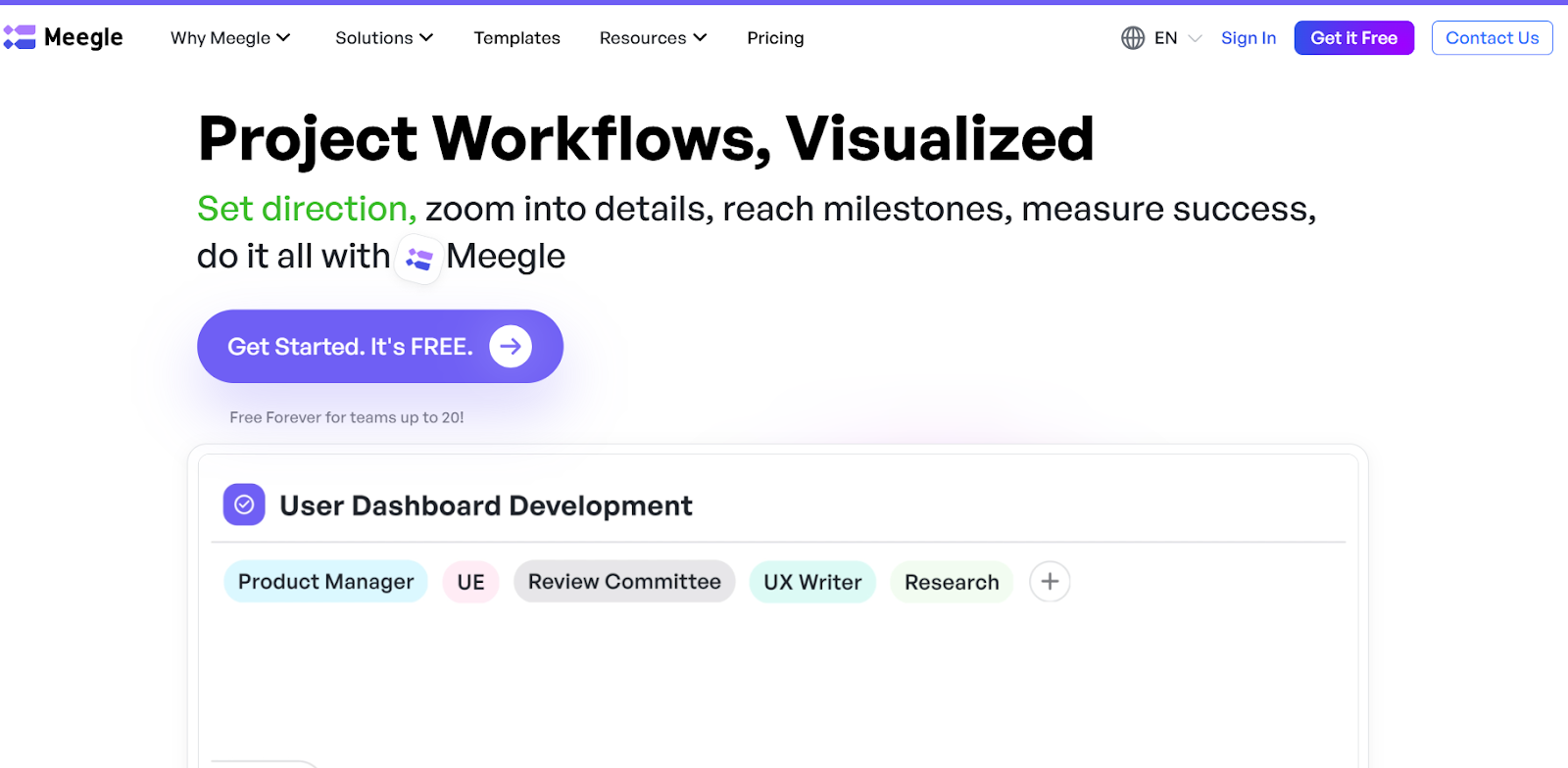 Meegle visual project management software
Meegle visual project management softwareMeegle turns project plans into live, actionable workflows, giving teams clarity and direction at every step. Visual workflows simplify task assignments, progress tracking, and dependency management, keeping managers fully in control throughout the execution phase
With built-in collaboration tools and automated status updates, Meegle reduces delays and miscommunication during critical execution phases. It ensures that every team member knows what to do, when to do it, and how it contributes to broader project goals.
Here’s where execution tends to fall apart and how Meegle’s systems match the associated problems with structured clarity:
| Problems | What it looks like | How Meegle handles it | Who this helps |
|---|---|---|---|
| Tasks disappear into silos | People work, but no one knows what’s done or stuck | Centralized task boards, real-time updates | Project leads trying to unblock without micromanaging |
| Updates don’t reach everyone | Someone makes a change, others don’t adjust | Automated alerts, role-based notifications | Teams that rely on timing and sequence (e.g., dev → QA) |
| Scope creeps | People adjust deliverables based on guesswork | Change logs and role-linked task history | PMs managing sponsor expectations |
| Accountability is fuzzy | Delays happen, and no one knows who to ask | Node-linked roles and escalation triggers | Functional managers balancing multiple contributors |
| Timelines are outdated | Teams report weekly; the plan drifted daily | Live dashboards and OKR-aligned progress tracking | Executives needing real-time project health |
| Feedback stays verbal | Clients or stakeholders give verbal feedback and are never logged | Comment threads and task-level documentation | Client-facing PMs who need to backtrack decisions |
| Replanning wrecks structure | One delay leads to untracked ripple effects | Workflow-based dependency mapping | Cross-stream PMs in hybrid or fast-moving teams |
PM tools don’t do all the work. People do. But the right tool absorbs the disorder so your people don’t have to. If your team already knows how to plan, Meegle helps you actually deliver: it makes execution visible, traceable, and recoverable, so small misses don’t become big problems.
Streamline your project execution with Meegle’s clear workflows, real-time updates, and structured collaboration.
FAQs
What are the key deliverables of the project execution phase?
Deliverables include:
- Actual project outputs (products, services)
- Updated documentation (change logs, revised timelines)
- Performance data
- Issue logs
- Validated milestones
Each of these serves as proof of execution progress and input for monitoring and project closeout.
What tools are used in project execution
Execution relies on project management software (e.g., Meegle), communication platforms (Slack, MS Teams), dashboards for progress tracking, and tools for task assignment, change control, and collaboration.
How long does the project execution phase usually last?
It varies by project size and complexity, but is often the most extended phase (ranging from weeks to years). Execution continues until all deliverables are produced and accepted, frequently overlapping with monitoring and adjustments.
How can I improve team accountability during execution?
People follow through when they feel seen, expectations are clear, and they see that their contributions are tied to visible progress. Use transparent tools, peer-aware updates, and shared rituals like retros or stand-ups to build a culture where no one wants to drop the ball.
What happens if a task falls behind schedule during execution?
Delays happen, and if left unmanaged, a single stalled task can derail the timeline, overrun the budget, and necessitate uncomfortable trade-offs at delivery.
The world’s #1 visualized project management tool
Powered by the next gen visual workflow engineRead More
Check All BlogsStart creating impactful work today



